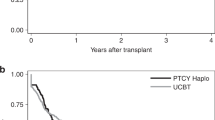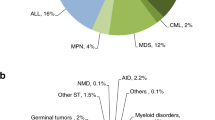Abstract
One of the truly revolutionary advances in hematopoietic cell transplantation (HCT) is the increasingly successful use of alternative donors, thereby allowing the delivery of a potentially curative transplant to ∼75% of patients who do not have an HLA-matched sibling donor. A substantial proportion of the need has been met by HLA-matched volunteer unrelated donors, but an unmet need still exists, particularly among minority populations and for people who need a more immediate source of hematopoietic cells. Two such sources, umbilical cord blood (UCB) and haploidentical related donors, have filled most of this need, and outcomes following transplants from these donor sources are very promising. UCB has the advantages of ready availability and is less capable of causing GVHD but hematological recovery and immune reconstitution are slow. Haploidentical HCT is characterized by the nearly uniform and immediate availability of a donor and the availability of the donor for post transplant cellular immunotherapy, but is complicated by a high risk of GVHD and poor immune reconstitution when GVHD is prevented by vigorous ex vivo or in vivo T-cell depletion. This review will discuss the pertinent issues that affect the choice of one donor source over another and offer recommendations regarding the optimal utilization of these donor sources.
This is a preview of subscription content, access via your institution
Access options
Subscribe to this journal
Receive 12 print issues and online access
$259.00 per year
only $21.58 per issue
Buy this article
- Purchase on Springer Link
- Instant access to full article PDF
Prices may be subject to local taxes which are calculated during checkout

Similar content being viewed by others
References
Laughlin MJ, Barker J, Bambach B, Roc ON, Rizzieri DA, Wagner JE et al. Hematopoietic engraftment and survival in adult recipients of umbilical-cord blood from unrelated donors. N Engl J Med 2001; 344: 1815–1822.
Takahashi S, Ooi J, Tomonari A, Konuma T, Tsukada N, Olwa-Monna M et al. Comparative single-institute analysis of cord blood transplantation from related donors with bone marrow or peripheral blood stem cell transplants from related donors in adult patients with hematologic malignancies after myeloablative conditioning regimen. Blood 2007; 109: 1322–1330.
Ooi J, Takahashi S, Tomonari A, Tsukada N, Konuma T, Kato S et al. Unrelated cord blood transplantation after myeloablative conditioning in adults with acute myelogeneous leukemia. Biol Blood Marrow Transplant 2008; 14: 1341–1347.
Sanz J, Sanz MA, Saavedra S, Lorenzo J, Montesinos P, Senent L et al. Cord blood transplantation from unrelated donors in adults with high-risk acute myeloid leukemia. Biol Blood Marrow Transplant 2010; 16: 86–94.
Eapen M, Rocha V, Sanz G, Scaradavou A, Zhang MJ, Arcese W et al. Effect of graft source of unrelated donor hematopoietic stem-cell transplantation in adults with acute leukemia: a retrospective analysis. Lancet 2010; 11: 653–660.
Uchida N, Wake A, Takagi S, Yamamoto H, Matsuhashi Y, Matsumura J et al. Umbilical cord blood transplantation after reduced-intensity conditioning for elderly patients with hematologic diseases. Biol Blood Marrow Transplant 2008; 14: 583–590.
Rocha V, Mohty M, Gluckman E, Rio B . Reduced-intensity conditioning regimens before unrelated cord blood transplantation in adults with acute leukemia and other hematologic malignancies. Curr Opin Oncol 2009; 21: 531–534.
Barker JN, Weisdorf DJ, DeFor TE, Blazar BR, McGlave PB, Miller JS et al. Transplantation of 2 partially HLA-matched umbilical cord blood units to enhance engraftment in adults with hematologic malignancy. Blood 2005; 105: 1343–1347.
Verneris MR, Brunstein CG, Barker J, MacMillan ML, DeFor T, McKenna DH et al. Relapse risk after umbilical cord blood transplantation: enhanced graft-versus-leukemia effect in recipients of 2 units. Blood 2009; 114: 4293–4299.
Brunstein CG, Barker JN, Weisdorf DJ, DeFor TE, Miller JS, Blazar BR et al. Umbilical cord blood transplantation after nonmyeloablative conditioning: impact on transplantation outcomes in 110 adults with hematologic disease. Blood 2007; 110: 3064–3070.
Ballen KK, Spitzer TR, Yeap BY, McAfee S, Dey BR, Attar E et al. Double unrelated reduced-intensity umbilical cord blood transplantation in adults. Biol Blood Marrow Transplant 2007; 13: 82–89.
Cutler C, Stevenson K, Kim HT, Brown J, McDonough S, Herrera M et al. Double umbilical cord blood transplantation with reduced intensity conditioning and sirolimus-based GVHD prophylaxis. Bone Marrow Transplant 2011; 46: 273–277.
Brown JA, Stevenson K, Kim HT, Cutler C, Ballen K, McDonough S et al. Clearance of CMV viremia and survival after double umbilical cord blood transplantation in adults depends on reconstitution of thymopoiesis. Blood 2010; 115: 4111–4119.
Rocha V, Gluckman E . Improving outcomes of cord blood transplantation: HLA matching, cell dose and other graft-and transplantation-related factors. Br J Hematol 2009; 147: 262–274.
Matsumo N, Wake A, Uchida N, Ishiwata K, Aroaka H, Takagi S et al. Impact of HLA disparity in the graft-versus-host direction on engraftment in adult patients receiving reduced-intensity cord blood transplantation. Blood 2009; 114: 1689–1695.
van Rood JJ, Stevens CE, Smits J, Carrier C, Carpenter C, Scaradavou A . Reexposure of cord blood to noninherited maternal HLA antigens improves transplant outcomes in hematologic malignancies. Proc Natl Acad Sci USA 2009; 106: 19952–19957.
Frassoni F, Gualandi F, Podesta M, Rajola AM, Ibatici A, Piaggio G et al. Direct intrabone transplant of unrelated cord blood cells in acute leukemia: a phase I/II study. Lancet Oncol 2008; 9: 831–839.
de Lima M, McMannis J, Gee A, Kkomanduri K, Couriel D, Andersson BS et al. Transplantation of ex vivo expanded cord blood cells using the copper chelator tetraehylenepentamine: a phase I/II clinical trial. Bone Marrow Transplant 2008; 41: 771–778.
Dey BR, Spitzer TR . Current status of haploidentical stem cell transplantation. Br J Haematol 2006; 135: 423–437.
Aversa F, Reisner Y, Martelli MF . The haploidentical option high-risk hematologic malignancies. Blood Cells Mol Dis 2008; 40: 8–12.
Fuchs EJ, Huang XJ, Miller JS . HLA-haploidentical stem cell transplantation for hematologic malignancies. Biol Blood Marrow Transplant. 2010; 16 (Suppl 1): 557–563.
Truit RL, Rimm AA, Saltzstein EC, Rose WC, Bortin MM . Graft- vs-leukemia for AKR spontaneous leukemia-lymphoma. Transplant Proc 1976; 8: 569–574.
Drobyski WR, Klein J, Flomenberg N, Pietryoga D, Vesole DH, Margolis DA et al. Superior survival associated with transplantation of matched unrelated versus one-antigen-mismatched unrelated or highly human leukocyte antigen-disparate haploidentical family donor marrow grafts for the treatment of hematologic malignancies: establishing a treatment algorithm for recipients of alternative donor grafts. Blood 2002; 99: 806–814.
Burroughs LM, O′Donnell PV, Sandmaier BM, Storer BE, Luznik L, Symons HJ et al. Comparison of outcomes of HLA-matched related, unrelated, or HLA-haploidentical related hematopoietic cell transplantation following nonmyeloablative conditioning for relapsed or refractory Hodgkin lymphoma. Biol Blood Marrow Transplant 2008; 14: 1279–1287.
Powles RL, Morgenstern GR, Kay HE . Mismatched family donors for bone-marrow transplantation as treatment for acute leukaemia. Lancet 1983; 1: 612–615.
Beatty PG, Cliff RA, Mickelson EM . Marrow transplantation from related donors other than HLA-identical siblings. N Engl J Med 1985; 313: 765–771.
Spitzer TR, McAfee SL, Dey BR, Colby C, Hope J, Grossberg H et al Nonmyeloablative haploidentical stem-cell transplantation using anti-CD2 monoclonal antibody (MEDI-507)-based conditioning for refractory hematologic malignancies. Transplantation 2003; 75: 1748–1751.
Mehta J, Singhai S, Gee AP, Chang KY, Godder K, van Rhee F et al. Bone marrow transplantation from partially HLA-mismatched donors for acute leukemia: single center experience of 201 patients. Bone Marrow Transplant 2004; 33: 389–397.
Aversa F, Terenzi A, Tabilio A, Falzetti F, Carotti A, Ballanti S et al. Full haplotype-mismatched hematopoietic stem-cell transplantation: a phase II study inpatients with acute leukemia at high risk of relapse. J Clin Oncol 2005; 23: 3447–3454.
Rizzieri DA, Koh LP, Long GD, Gasparetto C, Sullivan KM, Horwitz M et al. Partially matched, nonmyeloablative allogeneic transplantation: clinical outcomes and immune reconstitution. J Clin Oncol 2007; 25: 690–697.
Luznik L, O’Donnell PV, Symons HJ, Chen AR, Leffell MS, Zahurak M et al. HLA-haploidentical bone marrow transplantation for hematologic malignancies using nonmyeloablative conditioning and high-dose, posttransplantation cyclophosphamide. Biol Blood Marrow Transplant 2008; 14: 641–650.
Huang XJ, Liu DH, Liu KY, Xu LP, Chen H, Han W et al. Treatment of acute leukemia with unmanipulated HLA-mismatched/haploidentical blood and bone marrow transplantation. Biol Blood Marrow Transplant 2009; 15: 257–265.
Ruggeri L, Capanni M, Urbani E, Perruccio K, Schlomchik WD, Tosti A et al. Effectiveness of donor natural killer cell alloreactivity in mismatched hematopoietic transplants. Science 2002; 295: 2097–2100.
Symons HJ, Leffell MS, Rossiter ND, Zahurak M, Jones RJ, Fuchs EJ . Improved survival with inhibitory killer immunoglobulin receptor (KIR) gene mismatches and KIR haplotype B donors after nonmyeloablative HLA-haploidentical bone marrow transplantation. Biol Blood Marrow Transplant 2010; 16: 533–542.
van Rood JJ, Loberiza Jr FR, Zhang MJ, Oudshoorn M, Claas MS, Champlin RE et al. Effect of tolerance to noninherited maternal antigens on the occurrence of graft-versus-host disease after bone marrow transplantation from a parent or an HLA-haploidentical sibling. Blood 2002; 99: 1572–1577.
Stern M, Ruggeri L, Mancusi A, Bernardo ME, de Angelis C, Bucher C et al. Survival after T-cell depleted haploidentical stem cell transplantation is improved using the mother as donor. Blood 2008; 112: 2990–2995.
Ciurea SO, de Lima M, Cano P, Korbling M, Giralt S, Shpall EJ et al High risk of graft failure in patients with HLA-antibodies undergoing haploidentical stem-cell transplantation. Transplantation 2009; 88: 1019–1024.
Ball LM, Bernardo ME, Roelofs H, Lankester A, Cometa A, Egeler RM et al. Cotransplantation of ex vivo expanded mesenchymal stem cells accelerates lymphocyte recovery and may reduce the risk of graft failure in haploidentical hematopoietic stem-cell transplantation. Blood 2007; 110: 2764–2767.
Amrolia PJ, Muccioli-Casadei G, Huls H, Adams S, Durett A, Gee A et al. Adoptive immunotherapy with allodepleted donor T-cells improves immune reconstitution after haploidentical stem cell transplantation. Blood 2006; 108: 1797–1798.
Dodero A, Carniti C, Raganato A, Vendramin A, Farina L, Spina F et al. Haploidentical stem cell transplantation after a reduced-intensity conditioning regimen for the treatment of advanced hematologic malignancies: posttransplantation CD8-depleted donor lymphocyte infusions contribute to improved T-cell recovery. Blood 2009; 113: 4771–4779.
Yoon SR, Hee YS, Yang SH . Generation of donor natural killer cells from CD34+ progenitor cells and subsequent infusion after HLA-mismatched allogeneic hematopoietic cell transplantation: a feasibility study. Bone Marrow Transplant 2010; 45: 1038–1046.
Ciceri F, Labopin M, Aversa F, Rowe JM, Bunies D, Lewalle P et al. A survey of fully haploidentical hematopoietic stem cell transplantation in adults with high-risk acute leukemia: a risk factor analysis of outcomes for patients in remission at transplantation. Blood 2008; 112: 3574–3581.
Author information
Authors and Affiliations
Corresponding author
Ethics declarations
Competing interests
The authors declare no conflict of interest.
Rights and permissions
About this article
Cite this article
Ballen, K., Spitzer, T. The great debate: haploidentical or cord blood transplant. Bone Marrow Transplant 46, 323–329 (2011). https://doi.org/10.1038/bmt.2010.260
Received:
Accepted:
Published:
Issue Date:
DOI: https://doi.org/10.1038/bmt.2010.260
Keywords
This article is cited by
-
Haploidentical stem cells combined with a small dose of umbilical cord blood transplantation exert similar survival outcome of HLA-matched stem cells transplantation in T-cell acute lymphoblastic leukemia
Bone Marrow Transplantation (2020)
-
Haploidentical transplantation is associated with better overall survival when compared to single cord blood transplantation: an EBMT-Eurocord study of acute leukemia patients conditioned with thiotepa, busulfan, and fludarabine
Journal of Hematology & Oncology (2018)
-
Myeloablative conditioning regimens with combined of haploidentical and cord blood transplantation for myelodysplastic syndrome patients
Bone Marrow Transplantation (2018)
-
Longer delay of hematological recovery and increased transfusion needs after haploidentical compared to non-haploidentical stem cell transplantation
Bone Marrow Transplantation (2016)
-
A survey on unmanipulated haploidentical hematopoietic stem cell transplantation in adults with acute leukemia
Leukemia (2015)



